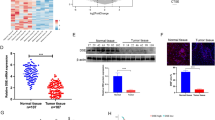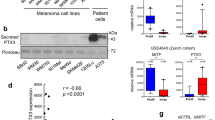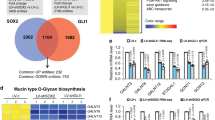Abstract
Melanoma chondroitin sulphate proteoglycan (MCSP) is a cell-surface antigen that has been implicated in the growth and invasion of melanoma tumours. Although this antigen is expressed early in melanoma progression, its biological function is unknown. MCSP can stimulate the integrin-α4β1-mediated adhesion and spreading of melanoma cells. Here we show that stimulated MCSP recruits tyrosine-phosphorylated p130cas, an adaptor protein important in tumour cell motility and invasion. MCSP stimulation also results in a pronounced activation and recruitment of the Rho-family GTPase Cdc42. MCSP-induced spreading of melanoma cells is dependent upon active Cdc42, a Cdc42-associated tyrosine kinase (Ack-1) and tyrosine phosphorylation of p130cas. Furthermore, vectors inhibiting Ack-1 or Cdc42 expression and/or function abrogate MCSP-induced tyrosine phosphorylation and recruitment of p130cas. Our findings indicate that MCSP may modify tumour growth or invasion by a unique signal-transduction pathway that links Cdc42 activation to downstream tyrosine phosphorylation and subsequent cytoskeletal reorganization.
This is a preview of subscription content, access via your institution
Access options
Subscribe to this journal
Receive 12 print issues and online access
$209.00 per year
only $17.42 per issue
Buy this article
- Purchase on Springer Link
- Instant access to full article PDF
Prices may be subject to local taxes which are calculated during checkout






Similar content being viewed by others
References
Hynes, R. O. Integrins: versatility, modulation, and signaling in cell adhesion. Cell 69, 443–475 (1992).
McCarthy, J. B., Skubitz, A. P., Palm, S. L., & Furcht, L. T. Metastasis inhibition of different tumor types by purified laminin fragments and a heparin binding fragment of fibronectin. J. Natl Cancer Inst. 80, 108–116 (1988).
Garofolo, A. et al. Involvement of the very late antigen 4 integrin on melanoma in interleukin-1-augmented experimental metastasis. Cancer Res. 55, 414–419 (1995).
Taichman, D. B. et al. Tumor cell surface alpha4beta1 integrin mediates adhesion to vascular endothelium: demonstration of an interaction with the N-terminal domains of INCAM-110/VCAM-1. Cell Reg. 2, 347–355 (1991).
Rice, G. E., Gimbrone, M. A. & Bevilacqua, M. P. Tumor cell-endothelial interactions. Am. J. Pathol. 133, 204–210 (1988).
Gehlsen, K. R., Davis, G. E. & Sriramaroa, P. Integrin expression in human melanoma cells with differing invasive and metastatic properties. Clin. Exp. Met. 10, 111–120 (1992).
Burridge, K., Turner, C. E. & Romer, L. H. Tyrosine phosphorylation of paxillin and pp125FAK accompanies cell adhesion to extracellular matrix: a role in cytoskeletal assembly. J. Cell Biol. 119, 893– 903 (1992).
LaFlamme, S. E. & Auer, K. L. Integrin signaling. Semin. Cancer Biol. 7, 111– 118 (1996).
Parsons, J. T. Integrin-mediated signalling: regulation by protein tyrosine kinases and small GTP-binding proteins. Curr. Opin. Cell Biol. 8, 146–152 (1996).
Cary, L. A., Han, D. C., Polte, T. R., Hanks, S. K. & Guan, J.-L. Identification of 130CAS as a mediator of focal adhesion kinase-promoted cell migration. J. Cell Biol. 140, 211–221 (1998).
Klemke, R. L. et al. CAS/Crk coupling serves as a ‘‘molecular switch’’ for induction of cell migration. J. Cell Biol. 140, 961–972 (1998).
Delisser, H. M. et al. Platelet/endothelial cell adhesion molecule-1 (CD31)-mediated cellular aggregation involves cell surface glycosaminoglycans. J. Biol. Chem. 268, 16037–16046 (1993).
Reisfeld, R. A. & Cheresh, D. A. Human tumor antigens. Adv. Immunol. 40, 323– 377 (1987).
Harper, J. R., Bumol, T. F. & Reisfeld, R. A. Characterization of monoclonal antibody 155.8 and partial characterization of its proteoglycan antigen on human melanoma cells. J. Biol. Chem. 132, 2096– 2104 (1984).
De Vries, J. E. et al. Characterization of melanoma-associated surface antigens involved in the adhesion and motility of human melanoma cells. Int. J. Cancer 38, 465–473 (1986).
Iida, J., Milius, R. P., Oegema, T. R., Furcht, L. T. & McCarthy, J. B. Role of cell surface proteoglycans in tumor cell recognition of fibronectin. Trends Glycosci. Glycotechnol. 6, 1–16 (1994).
Iida, J. et al. Spreading and focal contact formation of human melanoma cells in response to the stimulation of both melanoma-associated proteoglycan (NG2) and alpha4beta1 integrin. Cancer Res. 55, 2177–2185 (1995).
Iida, J., Meijne, A. M. L., Knutson, J. R., Furcht, L. T. & McCarthy, J. B. Cell surface chondroitin sulfate proteoglycans in tumor cell adhesion, motility, and invasion. Semin. Cancer Biol. 7, 155–162 (1996).
Iida, J. et al. A role for chondroitin sulfate glycosaminoglycan binding site in α4β1 integrin-mediated melanoma cell adhesion. J. Biol. Chem. 273, 5955–5962 (1998).
Ridley, A. J. & Hall, A. The small GTP-binding protein rho regulates the assembly of focal adhesions and actin stress fibers in response to growth factors. Cell 70, 389–399 (1992).
Nobes, C. D. & Hall, A. Rho, rac, and cdc42 GTPases regulate the assembly of multimolecular focal complexes associated with actin stress fibers, lamellipodia, and filopodia. Cell 81, 53–62 (1995).
Saoncella, S. et al. Syndecan-4 signals cooperatively with integrins in a Rho-dependent manner in the assembly of focal adhesions and stress fibers. Proc. Natl Acad. Sci. USA 96, 2805–2810 (1999).
Keely, P. J., Westwick, J. K., Whitehead, I. P., Der, C. J. & Parise, L. V. Cdc42 and Rac1 induce integrin-mediated cell motility and invasiveness via PI 3-kinase. Nature 390, 632–636 (1997).
Hildebrand, J. D., Taylor, J. M. & Parsons, J. T. An SH3 domain-containing GTPase-activating protein for Rho and Cdc42 associates with focal adhesion kinase. Mol. Cell. Biol. 16, 3169–3178 (1996).
Manser, E., Leung, T., Salhuddin, H., Tan, L. & Lim, L. A non-receptor tyrosine kinase that inhibits the GTPase activity of p21cdc42. Nature 363, 364–367 (1993).
Yang, W. & Cerione, R. A. Cloning and characterization of a novel Cdc42-associated tyrosine kinase, ACK-2, from bovine brain. J. Biol. Chem. 272, 24819–24824 (1997).
Yang, W., Lin, Q., Guan, J. L. & Cerione, R. A. Activation of the Cdc42-associated tyrosine kinase-2 (ACK-2) by cell adhesion via integrin β1. J. Biol. Chem. 274, 8524– 8530 (1999).
Tachibana, K. et al. Tyrosine phosphorylation of Crk-associated substrates by focal adhesion kinase. J. Biol. Chem. 272, 29083–29090 (1997).
Garrigues, H. J. et al. The melanoma proteoglycan: restricted expression on microspikes, a specific microdomain of the cell surface. J. Cell Biol. 103, 1699–1710 (1986).
Polte, T. R. & Hanks, S. K. Interaction between focal adhesion kinase and Crk-associated tyrosine kinase substrate p130cas. Proc. Natl Acad. Sci. USA 92, 10678–10682 (1995).
Harte, M. T., Hildebrand, J. D., Burnham, M. R., Bouton, A. H. & Parsons, J. T. P130cas, a substrate associated with v-Src and v-Crk, localizes to focal adhesions and binds to focal adhesion kinase. J. Biol. Chem. 271, 13649– 13655 (1996).
Nakamoto, T. et al. Requirements for localizations of p130cas to focal adhesions. Mol. Cell. Biol. 17, 3884– 3887 (1997).
Nobes, C. & Hall, A. Regulation and function of the Rho subfamily of small GTPases. Curr. Opin. Genet. Dev. 4, 77–81 (1994).
Qui, R. G., Abo, A., McCormick, F. & Symons, M. Cdc42 regulates anchorage-independent growth and is necessary for Ras transformation. Mol. Cell. Biol. 17, 3449–3458 (1997).
Nojima, Y. et al. Integrin-mediated cell adhesion promotes tyrosine phosphorylation of p130cas, a Src homology 3-containing molecule having multiple Src homology 2-binding motifs. J. Biol. Chem. 270, 15398– 15402 (1995).
Vuori, K. & Ruoslahti, E. Tyrosine phosphorylation of p130cas and cortactin accompanies integrin-mediated cell adhesion to extracellular matrix. J. Biol. Chem. 270, 22259– 22262 (1995).
Pluschke, G. et al. Molecular cloning of a human melanoma-associated chondroitin sulfate proteoglycan. Proc. Natl Acad. Sci. USA 93, 9710–9715 (1996).
Satyamoorthy, K. et al. Melanoma cell lines from different stages of progression and their biological and molecular analyses. Melanoma Res. 7(Suppl 2), 35–42 (1997).
Harper, J. R. & Reisfeld, R. A. Inhibition of anchorage-independent growth of human melanoma cells by a monoclonal antibody to a chondroitin sulfate proteoglycan. J. Natl Cancer Inst. 71, 259–263 (1983).
Bumol, T. F., Wang, Q. C., Reisfeld, R. A. & Kaplan, N. O. Monoclonal antibody and an antibody-toxin conjugate to a cell surface proteoglycan of melanoma cells suppress in vivo tumor growth. Proc. Natl Acad. Sci. USA 80, 529–533 (1983).
Burg, M. A., Grako, K. A. & Stallcup, W. B. Expression of the NG2 proteoglycan enhances the growth and metastatic properties of melanoma cells. J. Cell. Phys. 177, 299–312 (1998).
Teramoto, H. et al. The small GTP-binding protein rho activates c-Jun N-terminal kinases/stress-activated protein kinases in human kidney 293T cells. Evidence for a Pak-independent signaling pathway. J. Biol. Chem. 271, 27225–27228 (1996).
Kyriakis, J. M. et al. The stress-activated protein kinase subfamily of c-Jun kinases. Nature 369, 156–160 (1994).
Fidler, I. J. Rationale and methods for the use of nude mice to study the biology and therapy of human cancer metastasis. Cancer Metastasis Rev. 5, 29–49 (1986).
Bagrodia, S., Taylor, S. J., Creasy, C. L., Chernoff, J. & Cerione, R. A. Identification of a mouse p21Cdc2/Rac activated kinase. J. Biol. Chem. 270, 22731– 22737 (1995).
Taylor, S. J. & Shalloway, D. Cell cycle-dependent activation of Ras. Curr. Biol. 6, 1621– 1627 (1996).
Bagrodia, S., Taylor, S. J., Jordon, K. A., Van Aelst, L. & Cerione, R. A. A novel regulator of p21-activated kinases. J. Biol. Chem. 273, 23633– 23636 (1998).
Acknowledgements
We thank Y. Shimizu for valuable discussions. This work was supported by grant CA21463 from the NIH (to L.T.F.). L.T.F. is a recipient of an Allen-Pardee professorship in cancer biology.
Correspondence and requests for materials should be addressed to J.B.M.
Author information
Authors and Affiliations
Corresponding author
Rights and permissions
About this article
Cite this article
Eisenmann, K., McCarthy, J., Simpson, M. et al. Melanoma chondroitin sulphate proteoglycan regulates cell spreading through Cdc42, Ack-1 and p130cas. Nat Cell Biol 1, 507–513 (1999). https://doi.org/10.1038/70302
Received:
Revised:
Accepted:
Published:
Issue Date:
DOI: https://doi.org/10.1038/70302
This article is cited by
-
CSPG4: a prototype oncoantigen for translational immunotherapy studies
Journal of Translational Medicine (2017)
-
Functional ferritin nanoparticles for biomedical applications
Frontiers of Chemical Science and Engineering (2017)
-
Chondroitin sulfate effects on neural stem cell differentiation
In Vitro Cellular & Developmental Biology - Animal (2016)
-
Stonin1 mediates endocytosis of the proteoglycan NG2 and regulates focal adhesion dynamics and cell motility
Nature Communications (2015)
-
Chondroitin sulfate proteoglycan 4 functions as the cellular receptor for Clostridium difficile toxin B
Cell Research (2015)



